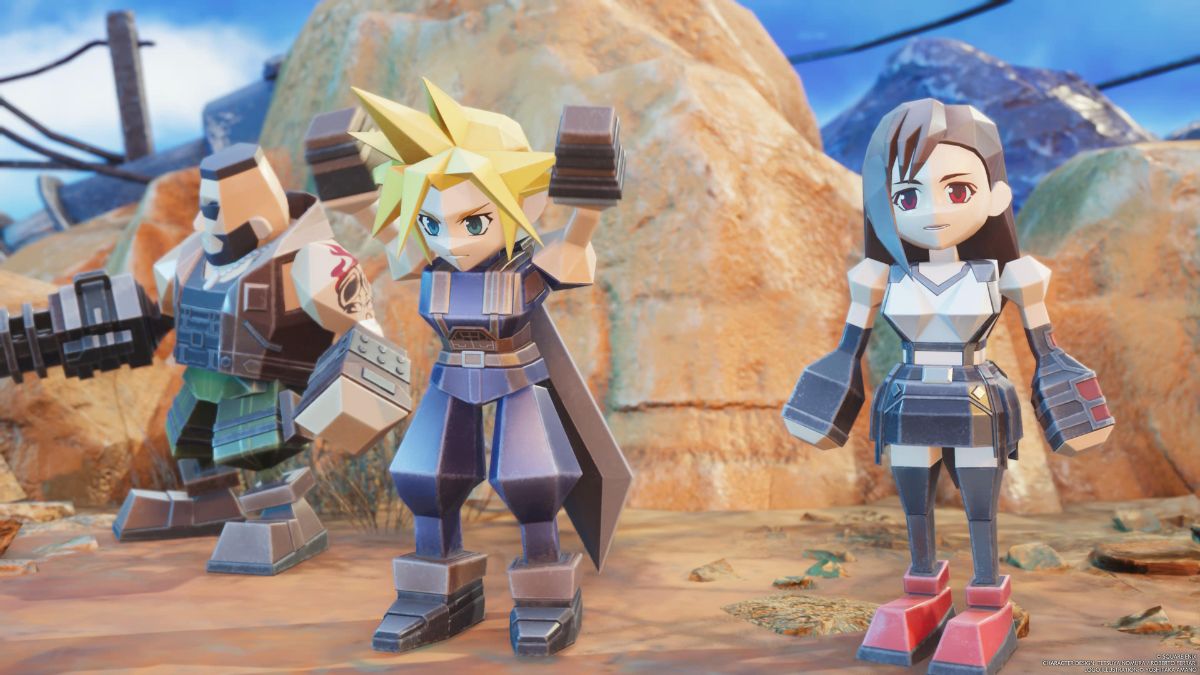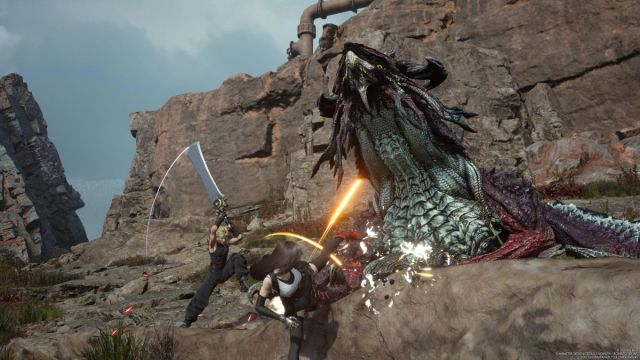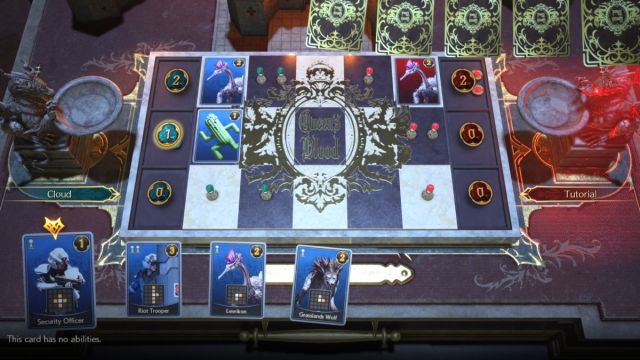Final Fantasy VII Rebirth Interview: Naoki Hamaguchi Talks Minigames, Queen’s Blood and Heartbreak
There's no wrong way to play Final Fantasy VII Rebirth.

Just a few days before the widely anticipated release of the second entry in the Final Fantasy VII Remake series, Final Fantasy VII Rebirth, I had the absolute privilege of sitting down with Director Naoki Hamaguchi at the Square Enix office in Los Angeles to pick his brain on not only the characters and relationships but the goofy side of Rebirth with its many minigames and new card game, Queen’s Blood.
This interview was conducted through an on-site translator.
An Interview with Final Fantasy VII Rebirth Director Naoki Hamaguchi
Meg Koepp: It’s very clear that you tried to go in depth with the characters with the new Synergy relationship system. Was that because you wanted players to form an emotional attachment to the characters to make the emotional moments more hard-hitting?
Naoki Hamaguchi: In terms of creating in-depth relationships among the characters, when we first received Nojima-san’s initial scenario, we felt that when looking into the characters’ pasts and the fate that they carry and following them, we are journeying with these characters to the ending of Rebirth. In that way, understanding the emotions and backgrounds that each carries just heightens these emotions that we feel towards them.
When constructing the world view of the game, this is not something that is a film; it’s a game, so you’re able to interact in that sense, and so I believe that, as a game designer, I find that we are much more partial to and find affinity towards gameplay when the actual world view and essence thematically are also reflected and makes for a much more immersive experience for the player. That was something we had in mind, and also, considering Nojima-san’s scenario and key thematic elements of going into the character relations, it was very much kept in mind.
Reflecting on that and expanding on that theme to encompass almost every element of the game, like the Synergy elements that you mentioned and combat in terms of affinity mechanics with the party members, even within the quests and the side content, are positioned in a way that deepens one’s understanding and relationships among the team members. In that way, all of these elements within the game tie back into this theme of continuing to grow these relationships. Since we were able to express this and have it all tie into each other, this reflected positively with the very wonderful Metacritic score and that reception.
Synergy Abilities are more than just powerful attacks: they really showcase the characters’ personalities. For example, Aerith will take Barret’s sunglasses. What are your favorite characters to pair off together?
Naoki Hamaguchi: In terms of my favorite Synergy ability and pairing, I think Cait Sith and Red XIII together; all their moves are very cute. When we look at the Synergy actions between Cloud and Tifa or Cloud and Aerith, they’re cooler and very stylish. But I think the essence of Final Fantasy VII and its unique worldview and why people really love it is due to a balance of serious storyline with these moments with comedic and funny elements. Cait Sith and Red XIII together are very cute, and the attacks are very entertaining, so I really love it that way.
The sunglasses you mentioned for Aerith and Barret’s Synergy – at first, those sunglasses were not there. As we continued to create these Synergy moves, on the dev side, we were thinking about what Synergy and this theme means. We came up with a ton of different ideas, and this was just another idea that popped up during that time. That kind of happens, too, where ideas come up as we work on them and are implemented as we continue to polish. That fun energy and excitement we had creating this can also be felt in that way.

Obviously, the original game on PlayStation was very linear compared to Rebirth. Were there any challenges associated with taking those areas and making them into such big, open-world regions?
Naoki Hamaguchi: I myself have been working on various Final Fantasy-related titles for about 25 years now, and in that time, the titles that I have worked on have tended to be more linear in terms of gameplay experience, but then now, when considering the Remake series and reconstructing this tale and looking towards gaining this new audience and expanding on this, I do feel that it’s necessary to enact a new gameplay experience that’s going to be positive for both this type of title and the franchise as well.
Looking at this within Rebirth, the world map was a great vehicle or way to really expand on this. And so, of course, keeping intact that very much cinematic and enriching main story, we are now branching out into having varied side content, quests, and mini-games that further enrich this experience by allowing a new degree of freedom in which players can make their own choice as to whether they wish to continue playing the main story and sticking to that. They also have the option to venture into different quests at any time freely.
By providing this experience, I think people will be able to discover this new Final Fantasy experience through Rebirth, and I think that having retained much of the staff from Remake into Rebirth was also very helpful in developing this scale of a game within the short time of four years. Both the team and I share the sentiment of feeling quite confident and very happy about this work. This is something that I think could perhaps feed into other triple-A titles as well.
Players can spend 50 hours just playing side content alone. How important was giving players side content that wasn’t just “go from point A to point B”?
Naoki Hamaguchi: Considering the main story and side content and the ratio, the side content is 2:1, almost double the volume of the main story of side content we were looking to create for this. The reasoning behind this is that by having this solid main story but also offering this side content that, in terms of volume, surpasses perhaps even double that of the main story, we avoid having the player feel as though they’re made to play the main story because that’s the only thing that is there.
In fact, there are tons of options; there’s freedom in choosing side content or the main story. In that way, we had gone away from that feeling of being made to play something and expanded into more freedom of choice in the gameplay and experience that will be unique to each person. Of course, filler-type quests were something that we would not like to have as well. So, quite early on, in the stages of development, we wanted these to be unique and varied, so we had determined the overall quantity of minigames and how in-depth we wanted to make each minigame as well.
With the quests, there’s a variety of them; someone may be playing a minigame, and another might not be in a minigame but deal with an original boss that you only encounter in this specific quest. Some may introduce a character from Remake that is reintroduced again, and now, we’re going further into their story, where we learn more about them through these quests. So there are all these types of quests and side content that each fulfill this role, and so by determining the overall structure and what types of content we wanted the players to experience, we were then able to have this overview of how this was going to look like and from there, it made it much easier to hone in on these details and decide what exactly we wanted to place and create. Including this type of variety and the experience one can gain allows us to proceed with excitement and wonder in experiencing each type. This makes people want to adventure off-path and see “what will happen if I go elsewhere” outside the main story. While this was challenging and quite a feat for us, it was something we were mindful of and took care to do within the dev team.
Another point I wanted to mention was that while there is such a huge number of minigames, no specific minigame team was solely working on them. It was more so that members would work in tandem; they would be in charge of some other aspect of the game and also be working on a minigame. For Queen’s Blood, there was no specific Queen’s Blood person who developed it, and actually, the person who worked on this was a battle planner who had worked on boss battles but was also creating the Queen’s Blood concurrently. Chocobo Racing was created by the person working on world map planning. So, in that way, having people somewhat juggle these other projects on their own is the reason why we were able to create so many minigames. [Laughs] The snowboard minigame was so popular that people were fighting to work on it.

My personal favorite side content is Queen’s Blood – I love it! Were there any challenges associated with making a new card game for Rebirth, and what made you want to include a card game?
Naoki Hamaguchi: When we were considering what types of minigames to include, we thought them in various categories. Some may be one-offs that you play, and others may be long-term ones that players will play throughout the game. When talking about what kind of game would be suitable to be played throughout Rebirth, we looked back on the mainline titles of the Final Fantasy series and saw that the long-term games were card games. So we did think perhaps players will feel some familiarity in having this card game in Rebirth.
That’s where we started, and within the dev team, there were quite a few creators who were big-time card game lovers and big fans of card games, so four or five of the card game hardcore lovers formed a unit to discuss and create the rules for Queen’s Blood. It was, honestly, quite a long road to get Queen’s Blood to what it looks like today; we played a ton of different card games, both physical and virtual ones, and made mockups with paper or used a simple Windows program to demo the gameplay. It took about a year or so to really develop and determine the overall game experience for Queen’s Blood, so there was a lot of work put into it, but I think since we took that time to really thoroughly go over what the game would look and feel like, from there it was smooth sailing going into actually implementing and developing it within the game. It could not have been done without the support and wonderful ideas generated by the team, and I’m so grateful for that. It’s become a wonderful piece of work.
As a side, when working with the card game unit, The Witcher 3’s Gwent card game served as a great reference point for us.
What do you love most about Queen’s Blood?
Naoki Hamaguchi: Around the midpoint of a Queen’s Blood battle, that’s the point where the cards become quite important and essential to the gameplay and how it will unfold. Right around then, opponents have more cards in their hands, so it becomes very difficult to put those cards down, and so it’s very exciting and a lot of fun.

It is very clear that Naoki Hamaguchi and the Final Fantasy VII Rebirth team have a lot of passion for not only the game and characters but also players and fans. This is something I felt radiated from Hamaguchi-san when talking to him in person; the love doesn’t switch off when game development ends. This was later echoed when I was given the opportunity to watch Advent Children with him and around 200 fans at a local movie theatre later that evening, where he took the time to address the crowd, give away t-shirts and signed posters, and pose for photographs afterward for every single person in the room, no matter how long it took.
Though I’d finished playing Final Fantasy VII Rebirth and I’d written and scored my review long before sitting down with Naoki Hamaguchi, hearing about and seeing the complete devotion he, his team, and Square Enix as a whole have for the Final Fantasy VII community makes it so hard not to fall even more in love with Final Fantasy VII Rebirth. There’s something truly special about knowing it was made by the game’s biggest fans. I said this in my review, but it really is the best game ever made, and I’ll die on that hill.
